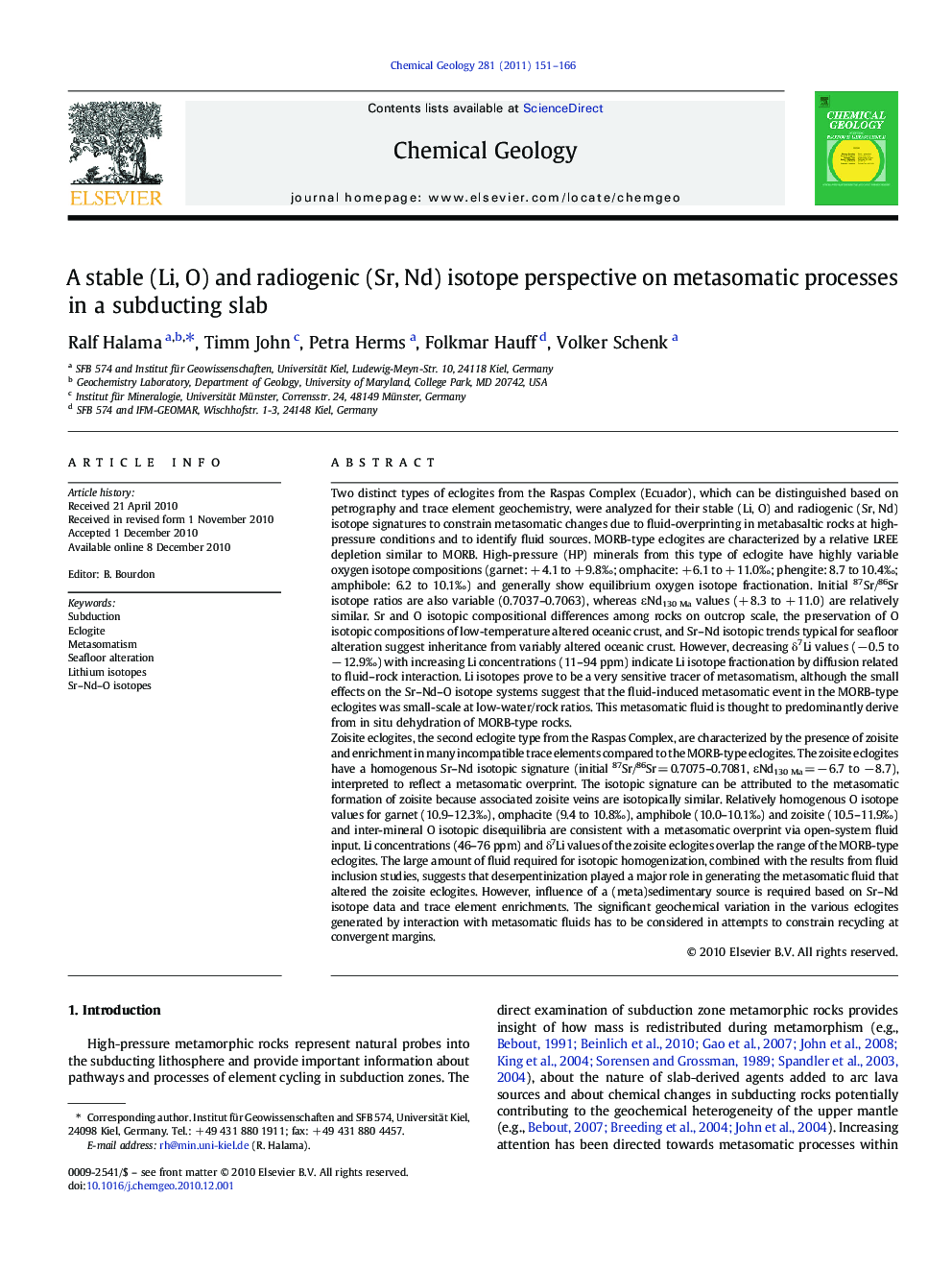| Article ID | Journal | Published Year | Pages | File Type |
|---|---|---|---|---|
| 4699738 | Chemical Geology | 2011 | 16 Pages |
Two distinct types of eclogites from the Raspas Complex (Ecuador), which can be distinguished based on petrography and trace element geochemistry, were analyzed for their stable (Li, O) and radiogenic (Sr, Nd) isotope signatures to constrain metasomatic changes due to fluid-overprinting in metabasaltic rocks at high-pressure conditions and to identify fluid sources. MORB-type eclogites are characterized by a relative LREE depletion similar to MORB. High-pressure (HP) minerals from this type of eclogite have highly variable oxygen isotope compositions (garnet: + 4.1 to + 9.8‰; omphacite: + 6.1 to + 11.0‰; phengite: 8.7 to 10.4‰; amphibole: 6.2 to 10.1‰) and generally show equilibrium oxygen isotope fractionation. Initial 87Sr/86Sr isotope ratios are also variable (0.7037–0.7063), whereas εNd130 Ma values (+ 8.3 to + 11.0) are relatively similar. Sr and O isotopic compositional differences among rocks on outcrop scale, the preservation of O isotopic compositions of low-temperature altered oceanic crust, and Sr–Nd isotopic trends typical for seafloor alteration suggest inheritance from variably altered oceanic crust. However, decreasing δ7Li values (− 0.5 to − 12.9‰) with increasing Li concentrations (11–94 ppm) indicate Li isotope fractionation by diffusion related to fluid–rock interaction. Li isotopes prove to be a very sensitive tracer of metasomatism, although the small effects on the Sr–Nd–O isotope systems suggest that the fluid-induced metasomatic event in the MORB-type eclogites was small-scale at low-water/rock ratios. This metasomatic fluid is thought to predominantly derive from in situ dehydration of MORB-type rocks.Zoisite eclogites, the second eclogite type from the Raspas Complex, are characterized by the presence of zoisite and enrichment in many incompatible trace elements compared to the MORB-type eclogites. The zoisite eclogites have a homogenous Sr–Nd isotopic signature (initial 87Sr/86Sr = 0.7075–0.7081, εNd130 Ma = − 6.7 to − 8.7), interpreted to reflect a metasomatic overprint. The isotopic signature can be attributed to the metasomatic formation of zoisite because associated zoisite veins are isotopically similar. Relatively homogenous O isotope values for garnet (10.9–12.3‰), omphacite (9.4 to 10.8‰), amphibole (10.0–10.1‰) and zoisite (10.5–11.9‰) and inter-mineral O isotopic disequilibria are consistent with a metasomatic overprint via open-system fluid input. Li concentrations (46–76 ppm) and δ7Li values of the zoisite eclogites overlap the range of the MORB-type eclogites. The large amount of fluid required for isotopic homogenization, combined with the results from fluid inclusion studies, suggests that deserpentinization played a major role in generating the metasomatic fluid that altered the zoisite eclogites. However, influence of a (meta)sedimentary source is required based on Sr–Nd isotope data and trace element enrichments. The significant geochemical variation in the various eclogites generated by interaction with metasomatic fluids has to be considered in attempts to constrain recycling at convergent margins.
Research Highlights► Eclogites from the Raspas Complex show variable degrees of metasomatic overprint. ► Distinct metasomatic effects on various stable and radiogenic isotope systems. ► Li isotopes are most sensitive to fluid-induced metasomatism. ► Metasomatism in zoisite eclogites involved a (meta)sedimentary fluid component.
